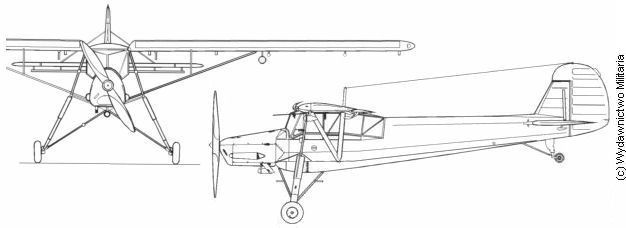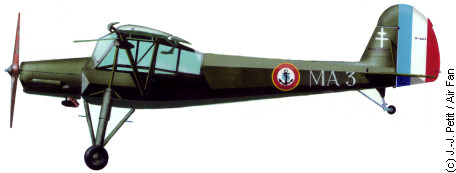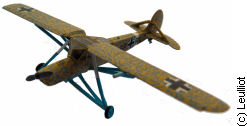
|
 Modelling the Morane-Saulnier MS.500
|
||||||||||||||||||
|
Best known for its wartime use by the Luftwaffe, the remarkable Fieseler Fi.156 Storch became synonymous with air operations over Indochina in the years following World War 2. Initially produced at the Fieseler plant in Kassel, in April 1942 the Storch also entered production for the Luftwaffe in the Morane-Saulnier works in the Paris suburbs and 141 aircraft had been delivered at the end of the year. With the Reich's air industry mobilized to meet the growing demand for home defence fighters, the Fieseler plant was switched to making the Focke-Wulf FW 190 and Storch production was entirely transferred to France and Czechoslovakia. In order to rebuild both its air force and its aircraft industry in the immediate post-war period, the French government decided to keep a number of German designs in production and 925 Fi.156s were ordered under their new designation, the Morane-Saulnier MS.500 Criquet, while around 65 Störche captured as war booty were turned over to the Armée de l'Air. Used for observation, liaison and casualty evacuation, the Criquet soon became a common sight over Indochina.
In 1/144 scale, the choice is limited to the pre-assembled Fieseler
Fi.156 Storch released by
Takara as part of their World Tank Museum
series of gashapon collectible
toys. While this is not quite a Criquet,
it is a good base for a conversion. Indeed, early production Criquets
were no different from the wartime Fi.156 C-7s or D-1s, some were in
fact
ex-Lutfwaffe planes with new markings. |
| Dimensions: | Wingspan | Length |
| Plane (m) | 14.25 | 9.9 |
| Model (cm) | 9.6 |
6.55 |
| Scale | 1/148 |
1/151 |
Required modification.
Although the model can simply be repainted as a Criquet, some simple modifications can significantly enhance it.First of all, the wings should have the recessed area mentioned above filled with putty and sanded flush. This not only gets rid of a poor rendition of ribbing, it is also more accurate for the aluminium-skinned wings favoured in Indochina because of the climate.
The fuselage profile also needs to be corrected by filing the bottom to make it shallower underneath the observer’s position. Next are the wing struts which are carefully prised off, thinned down and reattached after the painting stage (thus giving easier access to the canopy). Alternatively, the original wing struts can be binned and replacements cut from thin plasticard substituted. This has the additional advantage of allowing a more correct placement of the struts, the original ones being attached too low on the fuselage. Secondary struts can be added from brass wire though this can really be done only if you replace the original wing struts. As for the huge tailplane struts, they are best cut and scaped off before being replaced by thin plasticard.


Colours and markings
While the Criquets wore a simple overall dark olive green livery, there is some doubt as to the actual shade.A dark olive green roughly similar to FS 34091 is mentioned in Fi 156 Storch Vol.1 while French modelling magazines mention a paint close to FS 34079. Given that the Puteaux plant originally produced these aircraft for the Lutfwaffe, it is probably safe to assume it was in fact some local equivalent of RLM 71 Dunkelgrün and subject to variations. While some sources mention Olive Drab (FS 34087), it is doubtful that this shade was used on Criquets in Indochina although it certainly was worn some time later in Algeria.
Markings were simple and were limited to regulation roundels in the six usual locations, a fuselage code, usually one or two letters, and the regulation tricolour rudder. A very large proportion of Criquets wore a factory-applied white cross of Lorraine on the tail. Aircraft used as FACs sometimes wore a white square on each upper wing to make them easier to spot fom the air though this was far from universal.
 |
| This Navy Criquet
was assigned as a hack aircraft to the Tan Son Nhut mobile base. |
Criquets of the fledging Vietnamese, Laotian and Cambodian air forces followed a similar system with national flags on the rudder. VNAF aircraft wore a single letter in the GAOC or a number in the CIAVN as a fuselage code, while Lao and Khmer Criquets were too few to warrant fuselage codes, the tail serial number being sufficient.
 |
 |
|
Criquet of the VNAF's 1er Groupe Aérien d'Observation et
de Combat (1953)
|
Criquet of the Laotian Air Force's
1re Escadrille
d'Observation (1954)
|
Sources
- Dariusz KARNAS & Pawel PRZYMUSIALA, Fi 156 Storch Vol.1 (Militaria n.68), Wydawnictwo, Warsaw, 1998, ISBN 83-7219-019-4
- Dariusz KARNAS & Pawel PRZYMUSIALA, Fi 156 Storch Vol.2 (Militaria n.100), Wydawnictwo, Warsaw, 1999, ISBN 83-7219-059-3
- Heinz NOWARRA, Fieseler 156 "Storch", PPV GmbH, Fiedberg, 1979, ISBN 3-7909-0120-2
- Philippe RICCO & Jean-Claude SOUMILLE, Les Avions Allemands aux Couleurs Francaises, Tome 1, Airdoc, Rochemaure, 1997, no ISBN
- Jean-Claude SOUMILLE, L'Aviation Francaise en Indochine 1946-1954, Tome 2, Airdoc, Rochemaure, 1997, no ISBN
- Airliner.net's
excellent photo archives have several pages of photos covering the MS
Criquet and Fieseler
Storch

 Available model
Available model The model comes
entirely pre-assembled and pre-painted in one of four
schemes: overall dark green, overall sand yellow, sand/green camouflage
and overall white winter scheme.
The model comes
entirely pre-assembled and pre-painted in one of four
schemes: overall dark green, overall sand yellow, sand/green camouflage
and overall white winter scheme. 







